|
|
|
Sort Order |
|
|
|
Items / Page
|
|
|
|
|
|
|
| Srl | Item |
| 1 |
ID:
170340
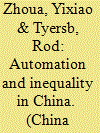

|
|
|
|
|
| Summary/Abstract |
In transitional economies, low wages imply sub-OECD yet growing labor shares of value added. China's rapid development has, however, seen a declining low-skill labor share and rising inequality. Here, a stylized model with three households and separable TFP and factor bias suggests a third of the decline in the low-skill share since 1994 is due to structural change and the rest mainly to skill-biased technical change. Expected future twists away from low-skill labor toward capital yield further inequality, moderated if strong TFP growth and population stability continue. But if the bias accompanies TFP shortfalls, worker displacement and rising inequality are in prospect.
|
|
|
|
|
|
|
|
|
|
|
|
|
|
|
|
| 2 |
ID:
078281


|
|
|
|
|
| Publication |
2007.
|
| Summary/Abstract |
The effects of Sino-US and Sino-EU safeguard agreements on US, Chinese and world cotton and textile sectors are investigated using a partial equilibrium model. The effects are compared to a free trade scenario under the provisions of the Agreement on Textiles and Clothing. The two safeguard agreements capping Chinese textile exports would decrease China's textile and apparel exports, production, and domestic consumption by an average 1.57, 0.63 and 0.32 percent, respectively. The safeguard agreements cause an increase in the US cotton textile price index and a slight decrease in US net textile imports and textile consumption. The agreements cause a decrease in the world cotton price and the quantity of cotton traded, but these trends reverse at safeguard expiration. The results generally support the view that the safeguard agreements forestall the effects of free trade in textiles and apparel rather than creating long lasting shifts in the textile trade.
|
|
|
|
|
|
|
|
|
|
|
|
|
|
|
|
| 3 |
ID:
171484
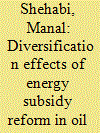

|
|
|
|
|
| Summary/Abstract |
For oil exporters, energy subsidy reform and economic diversification are critical policy responses to recent fundamental changes in the global oil market and oil price declines, yet the relationship between them is little understood. This article investigates linkages between energy subsidy reform and accelerating economic diversification away from hydrocarbons in a low oil price environment, using illustrations from Kuwait. It employs an economy-wide, general equilibrium model with oligopolistic industrial structure, the first of its kind for an economy in the Middle East and North Africa, that embodies unique elements of the country's economic structure—oil dependence; public sector dominance; subsidies; sovereign wealth funds; industrial collusive pricing behaviour; and guest workers. The article argues that, contrary to common popular discourse, Kuwait's economy has a diversified economic base, but this base fails to diversify export or government revenue needed for economic sustainability. Results show that weak economic diversification in oil exporters with a similar economic structure is not primarily due to “Dutch disease,” as dominant in the literature, but to economic constraints and distortions that impair structural change and exacerbate overdependence on hydrocarbons. Labour and competition reforms relax some constraints, achieving large efficiency gains that extend economy-wide and can expand non-energy tradable sectors. The analysis has important policy implications. First, the potential role of pricing regulation in small economies in moderating economic impacts of negative oil shocks. Second, in oil economies characterized by pervasive oligopolies, microeconomic reform can be a channel to achieve efficiency and better diversification effects of subsidy reform.
|
|
|
|
|
|
|
|
|
|
|
|
|
|
|
|
| 4 |
ID:
092858


|
|
|
|
|
| Publication |
2009.
|
| Summary/Abstract |
Most public policies, particularly those in the energy sphere, have not only efficiency but also distributional effects. However, there is a trade-off between modelling approaches suitable for calculating those impacts on the economy. For the former most of the studies have been conducted with general equilibrium models, whereas partial equilibrium models represent the main approach for distributional analysis. This paper proposes a methodology to simultaneously carry out an analysis of the distributional and efficiency consequences of changes in energy taxation. In order to do so, we have integrated a microeconomic household demand model and a computable general equilibrium model for the Spanish economy. We illustrate the advantages of this approach by simulating a revenue-neutral reform in Spanish indirect taxation, with a large increase of energy taxes that serve an environmental purpose. The results show that the reforms bring about significant efficiency and distributional effects, in some cases counterintuitive, and demonstrate the academic and social utility of this approximation
|
|
|
|
|
|
|
|
|
|
|
|
|
|
|
|
| 5 |
ID:
115174


|
|
|
|
|
| Publication |
2012.
|
| Summary/Abstract |
This paper disentangles the interactions between oil production profiles, the dynamics of oil prices and growth trends. We do so through a general equilibrium model in which Peak Oil endogenously emerges from the interplay between the geological, technical, macroeconomic and geopolitical determinants of supply and demand under non-perfect expectations. We analyze the macroeconomic effects of oil production profiles and demonstrate that Peak Oil dates that differ only slightly may lead to very different time profiles of oil prices, exportation flows and economic activity. We investigate Middle-East's trade-off between different pricing trajectories in function of two alternative objectives (maximisation of oil revenues or households' welfare) and assess its impact on OECD growth trajectories. A sensitivity analysis highlights the respective roles of the amount of resources, inertia on the deployment of non conventional oil and short-term oil price dynamics on Peak Oil dates and long-term oil prices. It also examines the effects of these assumptions on OECD growth and Middle-East strategic tradeoffs.
|
|
|
|
|
|
|
|
|
|
|
|
|
|
|
|
| 6 |
ID:
111142
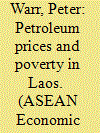

|
|
|
| 7 |
ID:
109315


|
|
|
|
|
| Publication |
2011.
|
| Summary/Abstract |
We investigate the economics of coal-to-liquid (CTL) conversion, a polygeneration technology that produces liquid fuels, chemicals, and electricity by coal gasification and Fischer-Tropsch process. CTL is more expensive than extant technologies when producing the same bundle of output. In addition, the significant carbon footprint of CTL may raise environmental concerns. However, as petroleum prices rise, this technology becomes more attractive especially in coal-abundant countries such as the U.S. and China. Furthermore, including a carbon capture and storage (CCS) option could greatly reduce its CO2 emissions at an added cost. To assess the prospects for CTL, we incorporate the engineering data for CTL from the U.S. Department of Energy (DOE) into the MIT Emissions Prediction and Policy Analysis (EPPA) model, a computable general equilibrium model of the global economy. Based on DOE's plant design that focuses mainly on liquid fuels production, we find that without climate policy, CTL has the potential to account for up to a third of the global liquid fuels supply by 2050 and at that level would supply about 4.6% of global electricity demand. A tight global climate policy, on the other hand, severely limits the potential role of the CTL even with the CCS option, especially if low-carbon biofuels are available. Under such a policy, world demand for petroleum products is greatly reduced, depletion of conventional petroleum is slowed, and so the price increase in crude oil is less, making CTL much less competitive.
|
|
|
|
|
|
|
|
|
|
|
|
|
|
|
|
| 8 |
ID:
090087
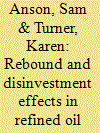

|
|
|
|
|
| Publication |
2009.
|
| Summary/Abstract |
In this paper, we use an energy-economy-environment computable general equilibrium (CGE) model of the Scottish economy to examine the impacts of an exogenous increase in energy augmenting technological progress in the domestic commercial Transport sector on the supply and use of energy. We focus our analysis on Scottish refined oil, as the main type of energy input used in commercial transport activity. We find that a 5% increase in energy efficiency in the commercial Transport sector leads to rebound effects in the use of oil-based energy commodities in all time periods, in the target sector and at the economy-wide level. However, our results also suggest that such an efficiency improvement may cause a contraction in capacity in the Scottish refined oil supply sector. This 'disinvestment effect' acts as a constraint on the size of rebound effects. However, the magnitude of rebound effects and presence of the disinvestment effect in the simulations conducted here are sensitive to the specification of key elasticities of substitution in the nested production function for the target sector, particularly the substitutability of energy for non-energy intermediate inputs to production.
|
|
|
|
|
|
|
|
|
|
|
|
|
|
|
|
| 9 |
ID:
143533
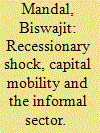

|
|
|
|
|
| Summary/Abstract |
Using the hybrid of Heckscher–Ohlin and Specific Factor models of trade, we show that the economic recession led to shock results for both capitalists and skilled workers. Some of the unionized unskilled workers lose formal sector employment and move onto the informal sector. When capital moves from the formal to the informal segments, both informal employment and wage can go up in latter’s segment. If capital does not move, informal employment expands and wage drops. Thus, recession may have actually benefitted a large number of informal workers.
|
|
|
|
|
|
|
|
|
|
|
|
|
|
|
|
|
|
|
|
|